The best way to see Director/Writer David Robert Mitchell’s It Follows is to take my word for it that it’s a better-than-average horror movie which prioritizes dread over gore, and it’s worth seeing in a theater with a bunch of other people. The less you know about the plot or even the basic premise the better. Ignore all the profile-boosting stories surrounding the film’s distribution strategy, which has now made it the little horror film that could as well as a test case for the way smaller films should decide whether to play in theaters or on VOD. In fact, stop reading this review, don’t even watch a trailer, and just go see the movie.
Are you still reading? I would be too if the roles were reversed because I’m simply not the kind of person who will pay to see something just because someone told me it was good. That piques my interest, sure, but I want to at least know what it’s about and who’s in it. Also, it wouldn’t hurt to see a TV commercial, trailer, or at least a poster to get a general idea of the visual style. I did all of those things (minus watching a commercial/trailer) before seeing It Follows, as did my friend, and we walked out of the theater struggling to characterize our disappointment, one of our first exchanges going something like, “It was good, don’t get me wrong, but I thought there were was going to be more to it”/“I know. I’ve seen better horror movies on VOD. Why is this one getting all the hype?”
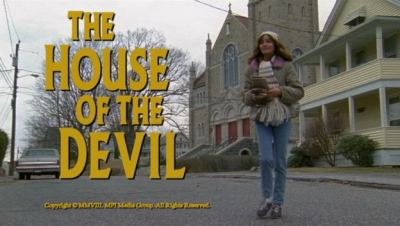
We both agreed that something like The House of the Devil is a far superior 80s homage and far scarier than It Follows
And therein lies the problem with It Follows at this very moment: how do you separate the film from the the hype? The actual film is a good, not great story about a 19-year-old girl (played by Maika Monroe) who has sex with her boyfriend and thus becomes part of a chain letter-like curse where she’s pursued by a shape-shifting monster until she passes the curse on through sexual contact with a new partner. It’s like a supernatural STD version of The Ring, the Japanese-turned-American horror film where the method of transferring the curse to someone else is making them watch a specific video. The hype argues It Follows is a “modern-classic” and “the creepiest movie in years” to go along with a 95% RottenTomatoes Fresh rating, a freakishly high total for any movie, but especially a horror movie.
That hype has been building since It Follows premiered at the Cannes Film Festival last year, where those in attendance enjoyed a pure viewing experience of not knowing what they were in for. What a delight to be utterly confused by the opening sequence in which an attractive teenage girl darts out of her suburban home and stares in temporarily paralyzed horror at something in the middle of the road, the camera panning to reveal that there’s nothing actually there. By the time the girl steals her bewildered father’s car and plunges headlong into the night the viewer’s curiosity is naturally peaked, examining each successive shot for any evidence of what exactly it is that has left her so terrified. This culminates in a beautifully shot scene with her sitting on the ground next to a desolate lake, using her car’s headlights for illumination as she calls her dad to apologize for all the mean things she’s ever said to him. Just when we think we see something in the distance the film smash cuts to a shot of her mangled corpse by the lake the next morning, followed by the ominous, red-lettered title card.
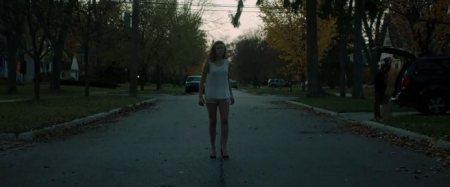
Don’t expect to learn anything more about this girl
If you already know the premise of It Follows, though, the inherent horror in the opening scene is somewhat cheapened. Oh, she clearly had sex, got the curse, and is being pursued by the titular “It” of the film, which can apparently only be seen by the afflicted. Beyond that, the opening sets you up for one of the most frustrating aspects of the movie: it’s never going to completely follow through on any of this as much as you might expect. For example, this is an opening kill scene akin to the legendary cold opens for every Scream movie, but in those cases the opening victims always turned out to at least somehow connect to the main characters. Granted, sometimes it was little more than a “they go to the same school together,” but the openings were story generators, not just tone-setters, setting off murder investigations. In the case of It Follows, the opening victim is never overtly referenced again even though at one point it would have made complete sense for someone to explain that she was his ex-girlfriend.
Clearly her story is over before it begins because It Follows only really cares about sisters Jay (Maika Monroe) and Kelly (Lili Sepe) and their friends Paul (Keir Gilchrist) and Yara (Olivia Luccardi), with neighborhood protector Greg (Daniel Zovatto, recalling a young Jack White) coming along a little later.
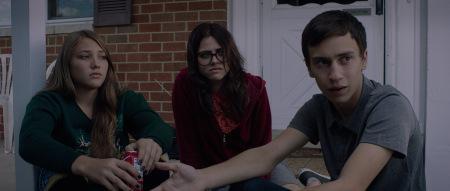
Kelly, Yara, Paul. We’re mostly expected to understand the blond girls are sisters and all the people with brown or black hair are their friends.
They all come off as convincing mumblecore teenagers, albeit ones from a different time period. If not for Yara’s pink sea shell shaped e-reader everything about these kids (their clothes, the way they talk) and the world they inhabit (bulky antenna TVs playing black and white 50s sci-fi/horror movies) screams 70s/80s. David Robert Mitchell freely admits his goal was to evoke the suburban setting and general feel of Haddonfield, Illinois in John Carpenter’s 1978 classic Halloween. However, Mitchell filmed It Follows in his hometown of Detroit, which also serves as the film’s setting, as acknowledged in a curious exchange prior to the big finale. So, he gives us a version of Haddonfield wrecked by decades of urban decay, Jay repeatedly looking out car windows and observing dilapidated buildings and abandoned houses. Similar to Halloween, the parents for all involved are either entirely absent or only occasionally around, usually without dialogue and shown out of focus, and the true star of the show is an eerie, synth-heavy musical score, provided by Rich Vreeland, which sounds like the respective scores for Halloween and Phantasm had a sinister baby.
The story is fairly basic and somewhat slow-moving at first, depicting normal suburban teenagers, their unrequited crushes, and the “do” or “do not” of going all the way with the boyfriend for the first time. The twist finally comes once Jay has sex, and in the horror movie equivalent of the guy having to tell the girl afterward that he has an STD her boyfriend straps her to a chair and explains that she has to have sex to escape a shape-shifting monster but if the monster kills the person she infects it will circle back to her.
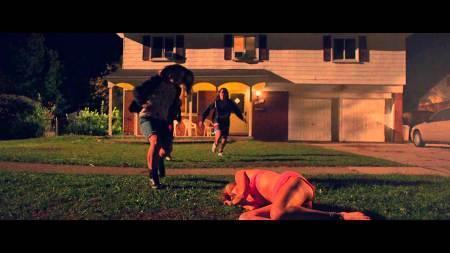
Don’t expect the obvious rape/sexual assault metaphor to figure as heavily as it could have
It’s an obvious inversion of the slasher movie norm, which posits a moralistic cinematic universe in which only the chaste survive and the sexually promiscuous are slaughtered without mercy. In It Follows, however, sexual agency is both the cause of and solution to all of life’s problems, although the ethical conundrum of being turned into a supernatural STD carrier who must fuck to survive is not as highlighted as you’d expect. That’s because this is not really a film which seems overly interested in making some kind of moral statement about sexual responsibility or the loss of innocence or equating the monster to the persistent anxieties of life or young adulthood or whatever, although others have interpreted all of that from what’s on screen. It more comes off like David Robert Mitchell had a vaguely clever idea he could use to marry his love for the teenagers in John Hughes movies to a recurring nightmare which everyone told him would make for a great horror movie:
I’m around 10 or 11 years old, and I’m at school, playing with my friends at recess. As I’m looking across the parking lot, I see a small kid, walking very slowly towards me. In the dream, I just know he’s a monster. I’d run away as fast as I could, then stop after a few blocks…and there was the kid, turning the corner and coming closer and closer. Sometimes, I’m at home with my family, but it’s the same thing: There’s someone coming for me. I climb out a window, I’m on the sidewalk, and it’s so slow I can easily get away from it. But it’s always there. I just can’t get away from it. It’s pretty common, actually. I’ve talked to a lot of people who’ve had this exact same recurring dream.
He has succeeded in realizing that nightmare on film. The most effective element of It Follows is the way it trains the audience to constantly be on the lookout for any kind of slowly approaching entity, put to rather brilliant use during crowd scenes at schools, the camera swiveling around in several 360s at one point as if you to ask, “Did you notice how that one girl outside the window and on the gross got progressively closer to the camera? That’s the monster! Shhh, don’t tell any of the characters. They haven’t noticed yet!” The first real instance of this starts off as a blatant rip-off of Jamie Lee Curtis staring out of a classroom window in Halloween before turning into something new, and it is used to similar effect in a later scene which initially appears lifted straight from Heather Langenkamp peering out her bedroom window in Nightmare on Elm Street.
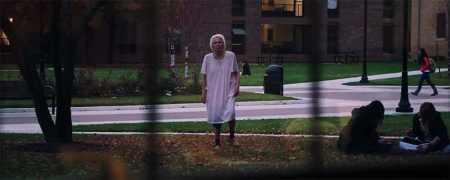
Of course, sometimes the “Where’s Waldo?” game of picking the monster out from the crowd is super easy. Can you guess who it is here?
And yet it could have been better. The monster can morph into any person, which would suggest you should expect eventual Invasion of the Body Snatchers-like or The Thing-like moments in which one of Jay’s friends rather suddenly turns out to be the monster. That almost never happens despite multiple occasions when it clearly could have. The monster’s morphing rarely serves any kind of character drama, instead pitched for ultra-creepiness, appearing as completely nude or partially nude older people, occasionally a giant bald man, and at one point a scary little kid. I personally found this more confusing than creepy, wondering why so many of the forms looked like sex victims, laughing to myself when the monster suddenly shows up on a rooftop for no real reason (I wanted to know how long it took it to get up there, and how long it would take to get down). Moreover, the exact rules governing the monster are best left unexplored in any level lest you quickly descend into, “So, does it have to be heterosexual sex? What about oral sex? Or what if two people are interrupted during sex, neither party getting to finish to completion? Does that still count as sex?” Also, apparently the monster likes to give potential victims a break if they’re unconscious, or at least that’s the only way I can explain certain scene transitions.
However, when I started going down that road while watching It Follows I was making the mistake of trying to make sense of it all. Like Halloween before it, It Follows is essentially about a bogeyman, and as Kim Newman said “the bogeyman doesn’t have to make sense, all he has to do is be scary.” My problem simply might be that I’ve seen too many horror movies by now to be scared by most of them anymore. As Grantland’s Mark Harris put it, “To love horror movies as an adult is to resign yourself to the probability that you are not going to be scared very often unless what you fear most in the world is nostalgia.” As I’ve already noted, the entire premise of It Follows is an inversion of a genre convention from the 80s, it lifts scenes from Halloween and Nightmare on Elm Street, and re-purposes the setting of Let the Right One In during its finale. It reminds me of the first time I heard the 2003 song “Are You Going to Be My Girl?” by the Australian band Jet. I thought it was a catchy rock song, but would I have felt the same way if I’d already heard the older, nearly identical song “Lust for Life” by Iggy Pop?
Of course, whether or not Jet ripped off Iggy Pop doesn’t have to alter your opinion of “Are You Gonna Be My Girl?”, and all of the genre homages throughout It Follows can be appreciated for how clever most of them are. This is, after all, an expertly made film with wonderfully naturalistic performances, a pervasive sense of dread that usually understands the power in leaving things to our imagination. It is often gorgeous to look at. There’s just, as my friend, not as much to all of it as you might like. Characters might break out into brief reflections on the sad state of Detroit or quote Dostoevsky’s The Idiot, as if to suggest the filmmaker had higher ideals in mind, and you can twist yourself silly trying to come up with some kind of explanation for what the monster might represent. It’s great that It Follows leaves you wanting to assign some kind of larger meaning. However, It Follows really is just about teenagers running from what they can never truly escape. There’s something almost elemental and clever about that; I just didn’t find it particularly scary.
SECOND OPINIONS
BadAssDigest: “There’s something lovely about a movie that can take a completely strange conceit and deliver as restrained a result as It Follows does. Like its monster, it’s a movie that sneaks up on you without you realising; unlike its monster’s victims, I’m really glad it did.
FilmSchoolRejects: “It Follows does wonders with the well-worn genre trope of sex=death, and while there are some nice moments of practical gore effects the terror here is far more tangible and long-lasting than any a traditional slasher could deliver. The ending makes a choice that may push away some viewers, but it works within the mashed-up world of teenage dreams and metaphorical nightmares.”

